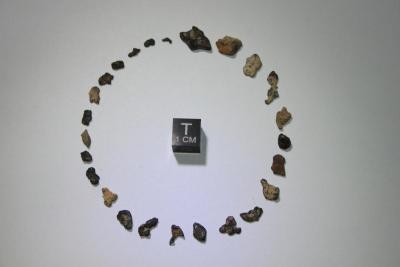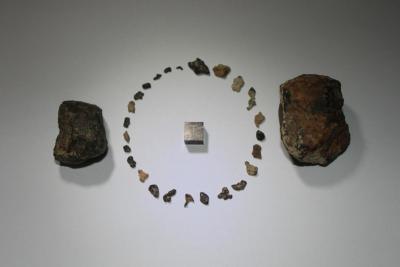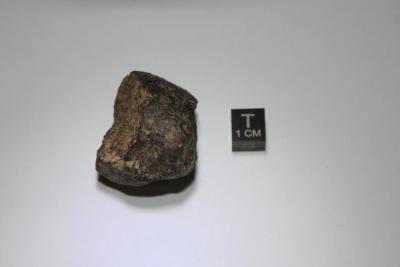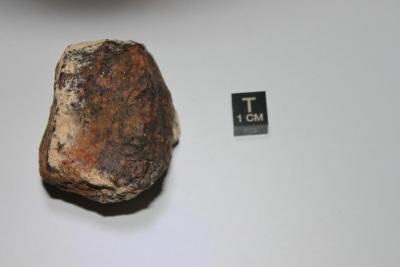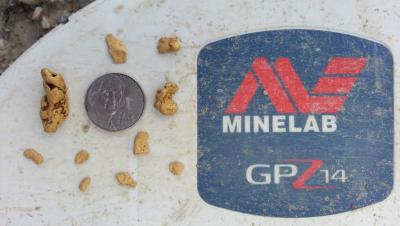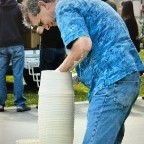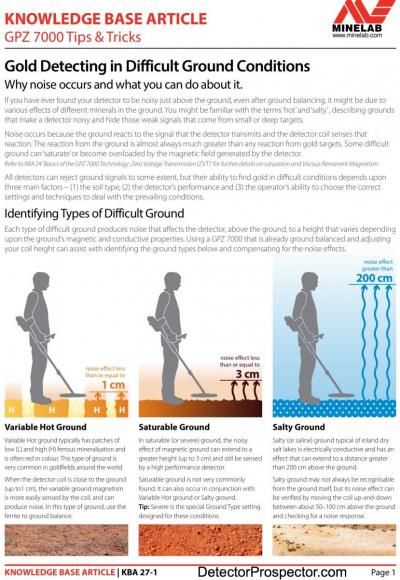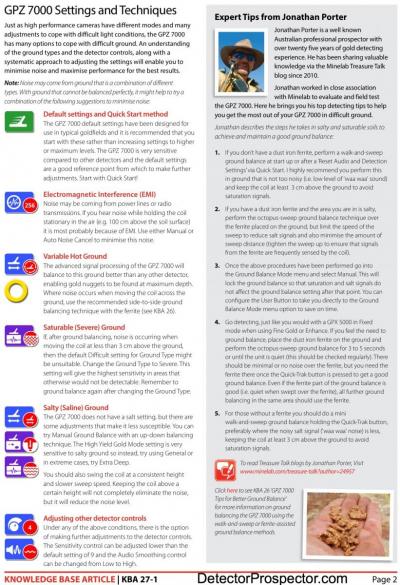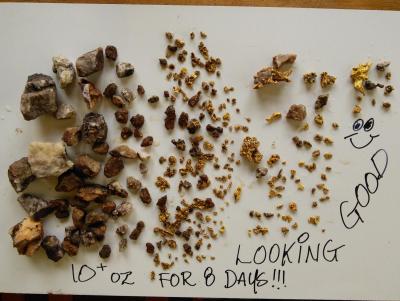Search the Community
Showing results for tags 'minelab gpz 7000'.
-
I thought we had a break in the weather down here in Southern CA so I took the 7k out to ironstone heaven. There is so much ironstone that Kaiser Steel once mined it nearby. I know of a small hillside placer that had produced a few dozen 1 gram and smaller nuggets. I used the 2300 in there last year for some decent finds. The problem is its a long, hot, dry walk. I was going to hike in and overnight it, but at the last minute decided a roundtrip with lighter pack was a better plan. I started out at first light with the 7k taken down and stowed in my pack with 4 liters of water. The hike was longer than I remembered, took me just shy of 2 hrs to get to the placer zone. I had already sweated through my shirt and drank one liter of water. Not a good start. I fired up the 7000 trying to concentrate on deeper gravels where the 2300 should have left some gold. Man, that 7000 can find ironstone real deep. I tried various settings to dumb it down, including General-Difficult with a lowered sensitivity. No go, too many golf ball sized chunks of ironstone down 6 to 10 inches. By noon I had enough of kicking and digging ironstone, even 1 nugget would have kept me going. By then I was down to 1.5 liter of water and it was heating up. I packed it up and plugged in my ipod with a decent audio book and hiked back out of there. I got to my truck about 2:30 and it was 105 degrees with 20mph winds. I hosed down with a 5 gallon jug of water, changed clothes and drove home. It was not a total loss, because I can now cross off my list a place to work the 7k. Looking forward to cooler temps and more time with the 7k.
-
I'm a new user. Working in rocky terrain, quartz and ironstone rich. I'm also of the age, where technicalities give me trouble. Can anyone give me the optimum settings for the detector, to suit such ground. Instruction manuals cause me head aches and confusion. Thanks in advance. Cheers Tony
-
Ok I got the ring thing. Now I'd like a few spare batteries. Don't like using my CTX half day ones. What do you think we will see first, the batteries or a coil?
-
G'day all I can't get out this weekend so I was wondering if there would be someone out there silly enough to give this a go. I was wondering what would happen if you taped the ferret in between the coil and skidplate. I have a small piece if foam there now to dull the noise (as per JP's advice) which does work well. Wondering what would happen if the ferret was there the whole time when detecting ???? Thoughts ???? Cheers BB
-
Anyone heard any chatter when Minelab will introduce a smaller coil for the GPZ? My arm is getting sore, but more importantly, it would be nice to be able to get between tight trees. Thanks, Rob
-
Just curious how it does on depth and sensitivity. Has anyone tested the Elite with some specimen type gold that the GPX misses but the 7000 screams on? Is anyone even running one over here? Most of the comments I see are in Australia. NF looks to also be coming out with a similar coil. I'm just curious how much and what sorts of improvements they give.
- 3 replies
-
- coiltek
- minelab gpx
-
(and 1 more)
Tagged with:
-
I went out to the Franconia meteorite strewn field last Friday. It is an area I know pretty good and I know a fair bit about the types of meteorites you can find there. One of the major types of meteorites is what they call an iron. It is a small meteorite that was blown by winds to their present location after a main mass burst in the atmosphere. They landed away from the main strewn field. Prior to the 8th of May I had never gotten more than 3 irons in a trip with various detectors and coils which includes a GPX 5000. Many thousands of these meteorites have been found over the years by hundreds of hunters. When you detect them the larger ones can scream at you. They are never very deep. This was a good and different trip. I had a Zed. I found 25 of the irons and a couple of larger meteorites. The largest iron at the top of the circle is .8 grams. It ends up with a tiny meteorite that I can't weigh. The total of all irons is 4.1 grams. The two larger meteorites are 46.7 grams and 114.4 grams. They were found in the same area with a depth of less then 5 inches. The Zed had no problem distinguishing them from the hot rocks. Now, bring on the gold fields!
-
I have been hunting with the GPZ for quite some time now. So I the am use to the GPZ being noisy it's like running the GPX 4500 very very hot or (maxing out). On this particular day the ground was saturated and as I dug down to recover a target I never hit any dry dirt. The GPZ will find the gold in wet conditions if you listen to what it's telling you through the noise. A proper ground balance and using the ferrite ring is a key part. On this outing I recovered 8.8 DWT and the largest being 5.4 DWT. The quarter ounce piece was at thirteen inches and broad signal. Happy Hunting, Road Dog
-
JP posted this video over a month ago at http://www.detectorprospector.com/forum/topic/1033-bogenes-settings/?p=10934 Since it is in another thread I decided to highlight it here in case somebody overlooked it. The video is just part of a detailed article on the subject JP did at https://www.minelab.com/emea/treasure-talk/using-the-gpz-7000-in-high-emi-conditions-and-audio-smoothing Be sure and check it out.
-
Some of the best customer service I've had from any company. After dropping my ZED and cracking the case and then having some screen issues a couple of weeks later, the repair of my detector could have gone any number of different ways, thankfully Minelab took very good care of me in the way they handled my problems with this GPZ. No complaints from me on how this was handled, in very short time from sending my unit in for repair Minelab sent me a brand new GPZ 7000 as a replacement at no charge covered under warranty. No hesitation on the part of minelab to take care of this and make ma a happy customer.
-
I finally popped for the 7000 after having a pretty good year with the 2300. Mike G took me out to his family claim in one of CA. famous hydraulic pits for a bit of practice and familiarization. Within 10 minutes I found a tiny .25 gram flattened gold nug at impressive depth for something that small, perhaps 4 or 5 inches. I pushed pretty hard for the next 3 hrs finding one more similar sized nugget. What I hadn't counted on was the terrain. We were hunting a steep hillside with a lot of cobble piles, downed timber, deep gullies and iron trash. The 7000 is a beast in that kind of terrain. No amount of tricked up harness/bungee support will help when you're pushing that big coil up and down in all directions against gravity. As you may recall in one of Steve's original posts about reasons not to get the 7000, he cautioned that it is best suited for open, flat ground. I was wore out after a 6 hr trial. Me and the 7000 were soundly beaten by another friend of Mike's pushing a belt mounted Eureka Gold with small coil. Despite the small coil, he could actually cover more ground, under, through and around the obstacles with a nearly weightless machine and iron discrimination. A better tool for those conditions without a doubt. It took me several hrs to get my ears and brain accustomed to the chatter from the 7000. I ran it in the preferred settings, High Yield/Difficult, gain 9, Smoothing off, but it just seemed noisy. I personally never thought the 2300 was that noisy and I ran mine through an small amplifier to boost the volume. Its all in what you're used to and I can understand the GPX users rocky transition. I need a few days in some more suitable terrain to really get a good feel for this machine. I may have to run out to the sagebrush flats of N. NV. I've got some promising shallow bedrock desert washes back in AZ that I can't wait to try, once the weather gets a little more tolerable. Until then boys and girls, keep er low and slow.
-
The Minelab GPZ 7000 audio Smoothing function was directly derived from the Stabilizer control used on the GPX series. From JP at http://www.detectorprospector.com/forum/topic/715-gold-i-found-in-victoria-with-the-gpz/?p=6424 "On the subject of Audio Smoothing: Off on the GPZ = 20 on the GPX 5000, Low equals 15 and High equals 10." JP at the link referenced obviously prefers Smoothing to be left off. Some people are experimenting with higher audio smoothing settings combined with either hotter Gold Mode settings or higher Sensitivity settings or both. I think this is a good thing so do not go thinking it is "wrong". There is no right or wrong per se, it is all about what works for each prospector and their personal tolerance for noise or the lack thereof. Experimentation is good. I thought it would be informative to copy what the GPZ manual (page 66) has to say about the Stabilizer control. Warning: the GPX Stabilizer control is backwards. The highest setting if 20 is the off position. Lower numbers increase smoothing. So the GPZ at off is same as GPX at 20 (off). Note that the GPZ High setting is the same as the GPX default setting of 10. The default for the GPZ 7000 is Low Smoothing which is the equivalent of a setting of 15 on the GPX. One final note. RX Gain as referred to on the GPX is the same as the Sensitivity control on the GPX. From the GPX manual: I guess I should say that my preferences tend to follow JPs - I run with audio Smoothing off under nearly all circumstances. But I wanted to make this post to create a thread on the subject as it is very clear people are having success with other ways of thinking and again, I like out of box thinking. Lunks settings at http://www.detectorprospector.com/forum/topic/830-lunks-zed-settings/ are at the other end of the spectrum. I also liked Jason's observation on the subject at http://www.detectorprospector.com/forum/topic/827-minelab-video-gpz-7000-ground-type/?p=8276
-
so, I was out at the rye patch with my gpz digging holes and having fun, I had just dropped a 40 caliber slug in my pocket and was down on one knee with my buddy zed resting atop the other. I let go of it for just a second while it was resting on my leg and twisted a little while using two hands to slip my pick in its holder and zed slipped about a foot and a half or so to the ground, the bungee was off. I checked it out and everything was working perfect so I'm thinking good no problem. Im swinging zed a little more and happen to take a closer look at the bottom and notice a crack in the case, now Im bummed my good friend zed is hurt and its my fault. the good news is everything is working fine, it did not fall far or hit hard but it did hit a pointed rock in just the right way i guess. the plastic case is egg shell thin so be very careful. I put a piece of tape over the crack and suppose I could just live with it but will likely call mine lab and find out the cost of repair. the good news, i was digging a nice signal near an old sage brush stump and found a Rye Patch meteorite the size of a dime... my first.
-
Gold Hound posted something at http://www.detectorprospector.com/forum/topic/1067-loving-the-zed/?p=11514 that really made me perk up: Bogene's settings are not for me. I have my own ideas, I care not about chattery emi noise or a fair bit of ground noise, in fact I like a fair bit of ground noise to tell me whats going on with mineralization under the coil I set mine for deep and small target sensitivity. I like a lot of noise coming back at me, most could not tolerate their detector as noisy as I run mine. But noise is like music to my ears, my gain has hardly ever had to go below 20. You'll hear how noisy it is in the vid. I've found that understanding the Ground Balance is critical with the Zed. I have found that fixed is very useful when you know when and how to best apply it. I've found that the most important thing in all metal-detecting is swing speed/hand eye to ear co-ordination. Most operators never fully master this skill. Once you truly master this skill ground noise or emi doesn't bother you much any more, even if its louder than the target response as the target noise frequency is greatly different to the emi or ground noise to a trained ear, and the target response frequency is directly relative to your swing speed. The swing speed can be varied greatly and used to ID a target from a strong concentrated ground noise. That is how I detect! Though my gain stays closer to 12. I also run my volume levels fairly low so the sounds are more a background sound than loud noises. But real targets just jump out to my ear. I wonder how many people are having fits over the GPZ 7000 and what they see as noise that makes it unuseable, and how many there are like me and Gold Hound who are experiencing the same thing and asking ourselves "what's your point"?
-
Hello my name is Cindy. I am new here and finding my way about. I am an archeologist by profession by the way. I enjoy digging around and finding old relics as much as you do. I just took delivery of the minelab gpz 7000 and i would like an honest personal view from anyone who has used it here. You are also free to ask me any questions.
-
I have been testing and comparing the GPZ –7000 since its conception. The 7000’s new technology is not like anything we have seen before. Here is the link to my Review and thoughts of the GPZ. http://gerrysdetectors.com/articlesreviewsblog/
-
We are really starting to get comfortable with our Zed's Here is a photo taken on day 8 of our last 2 week trip. We will be adding a vid of our last mission to our youtube channel soon.
-
I am starting a thread on GPZ discrimination. In this missive I use “discrimination” with reference to both hot rock and junk identification. Let me start with my hypothesis then describe how I got there. I am very much asking for corroborating or contradictory evidence to my hypothesis and other notes as well as any other useful info on GPZ 7000 discrimination. Hypothesis: Natural gold from small, barely perceptible signal return, to huge enough to provide overload, always produces a high-to-low tone when in high yield gold mode / general ground type settings. Natural Gold can sound either high-to-low or low-to-high in difficult or severe ground type settings. Ground type is the only user changeable setting that effects tone changes high-to-low or low-to-high on a particular target. Required Conditions: negligible EMI, negligible other metal or overriding hot rock present. The one thing that has been true to date in my field experience and experiments, is that every natural gold find or test nugget from small, barely perceptible to huge enough to provide overload, had a high-to-low tone when in high yield/general. I understand this hypothesis is no giant breakthrough enabling classification of the Zed as anything other than an all-metal machine as the Minelab manual and advertising clearly classify it. Nonetheless, it’s the entire useful conclusion I’ve come to in as few words I can make it. (I have trouble with writing few words. J ) Minelab makes no mention of discriminating sounds yet the pitch change of high-to-low or low-to-high is impossible to ignore, and naturally causes the curious to explore.* Early in my experimentation and Zed education, I spent hours determining what controls affected a reliable pitch change in different junk materials and hot rocks and gold. All kinds of elaborate charts in my notebook. I am glad I have not posted on this topic earlier because I have been through many cycles where experiments and field experiences would give me some preliminary beliefs which would soon thereafter be disproved by another experiment or field experience. What has emboldened me to make this post (as simple as the hypothesis is) is that I was fortunate recently to experiment on a very large gold in quartz specimen. Not certain on the mass of gold (> several ozs for sure) yet the return signal easily produces overload response on all gold type/ground type combinations. (No, not my gold. L ) The specimen produced high-to-low on high yield/general, low-to-high for difficult and severe ground types. Always true as I backed the Zed coil away from the specimen. This was enlightening and counter to my early Zed experimentation on aluminum where size of aluminum changed pitch direction. I found that the Zed, with no change in settings, will respond high-to-low on small pieces of aluminum foil (several mm x several mm) yet respond low-to-high on large (>100 mm x >100 mm) keeping high yield/general constant as well as all other settings. Zed responds low-to-high on soda and beer cans with high yield/general. So, I have wandered about assuming the same for gold (size of metal can affect pitch change) and hence I have NO DISCRIMINATION at all. I “convinced” myself of this when I tested a 1 gram nugget (high-to-low) then a very large men’s gold wedding band (low-to-high) keeping high yield/general constant as well as all other settings. Hence my hypothesis states “natural gold” to distinguish from alloys. Hot rocks, iron or mineral based, produce a symphonic range of return sounds and can be high-to-low or low-to-high on any ground type or gold mode setting. (another thread necessary on hot rock strategies.) My hypothesis of “Ground type is the only user changeable setting that effects tone changes high-to-low or low-to-high on a particular target.” is not in conflict with the fact that you can put audio smoothing on high and totally eliminate a return from a weak target. Audio smoothing setting does not change the pitch direction on a target. Iron. Man made iron and high % iron alloy objects produce low-to-high on all ground types only if the iron is not rusted heavily. If the iron is rusted it can produce high-to-low or low-to-high. This of course is near useless info for the prospector because most all iron stuff we find is rusted. Since I work in a hard rock environment, "dig it all" is just not practical. Hence, my experiments and documentation on the GPZ7000 tones to try and get any possible discrimination info out of it. In my environment, that mostly means hot rock. In my environment, I can prospect in high yield/general at least 90% of the time. Mineralization puts me in difficult or severe less than 10% of the time. I also have the “luxury” to mark interesting signal location first located by GPZ, then come back with my Whites MXT to try and discriminate. (Also have GMT, GB II and GB Pro available.) This works well on strong signals, or near-surface hot rock, however weaker GPZ signals produce inadequate response for any accurate discrimination from the VLFs. Even if your environment requires you to mostly search in difficult or severe ground type settings, you could always go high yield/general as a discrimination test right over the target. Of course then you might have "overriding hot rock" condition. I think the most opportunity for uselessness of my hypothesis, even if it's accurate, is that I just don't have much experience of gold in difficult or sever ground environments whereas that is much the norm elsewhere. * My previous Minelab experience is just ~ 80 hours with a GP3000, so I come to GPZ 7000 without much Minelab audio discrimination experience. I’m told on other posts in this forum that is a Zed education advantage.
-
My recommended GPZ 7000 Ground Balance Method for Salty Saturable soils: 1. If no "Dust Iron" Ferrite, perform a "Walk and Sweep" at start up or after a "Reset Audio and Detection Settings" via Quick Start. I highly recommend you perform this in ground that is not too waa waa (salty) and keep the coil above 30 mm to avoid saturation signals. 2. If you have a "Dust Iron" Ferrite and the area your in is Salty, then perform the Octopus sweep over the Ferrite laying on the ground but limit the speed of the sweep to avoid salt signals and also minimise the amount of sweep distance (tighten the sweep up). 3. Once the above procedure has been performed go into the "Ground Balance Mode" menu and select Manual, this will then lock the GB so that Saturation and Salt signals do not affect the GB after that point. You can configure the USER button to take you directly to the Ground Balance mode menu option to save on time if you like. 4. Go detecting just like you would with a GPX 5000 in Fixed Mode using Fine Gold or Enhance. If you feel the need to ground balance place the "Dust Iron" Ferrite on the ground and perform the Octopus sweep for 3 to 5 seconds or until the unit is quiet (this should be checked regularly). There should be minimal or nil noise over the Ferrite but you need it there once the Quick Trak button is pressed in to get a good GB even if the Ferrite part of the GB is still good. For those without a Ferrite you should do a mini "walk and sweep" with Quick Trak held in, preferably where the salt signal (waa waa noise) is less, keeping the coil above 30mm to avoid Saturation signals. Notes: By using Manual mode you stop the Salt and Saturation signals from interfering with the GB, salt signals can throw the GB out if in tracking mode, this also happens on a GPX 5000 when in Tracking mode. If the detector is exposed to strong Salt and Saturation signals when the Quick Trak button is depressed you could end up with an atypical Ground balance which is not good for effective metal detecting. People need to take into consideration the GPZ's ability to sample very early, due to this it's more aggressive on Salt signals and Saturation signals (probably by a magnitude of 2 or more but not as bad as a VLF), hence operators need to keep that in mind in Alkali or Saturable ground. By using Manual mode and attaining a good GB at start up and maintaining it by regularly checking with the Ferrite during the session you will not have to worry about Salt or Saturation signals affecting the GB. A slower sweep speed has always helped with salt so be prepared to slow down, salt signals vary from ground to ground even over small distances. If unsure it is salt your dealing with just lift the coil to waist height away from your body and listen for a faint to loudish broad signal, if so Salt is present. JP
-
Many of the prospectors here sometimes prospect in Northern Nevada, and like a number of GPZ users prospecting in northern Nevada, I have been experiencing issues in certain places with the GPZ moaning and groaning over wet ground that is a little bit salty. The amount of salt in the ground at various places in northern Nevada ranges from not salty at all to fairly salty with all ranges in between. When fully dried out this ground is no problem, but when wet it is a whole different story. Some places the salt is no issue, while in others it is very noticeable. Salt, by itself, is not conductive and dry salt will not respond to a metal detector, but when dissolved in water the salty solution is conductive. The extreme of this is wet ocean beach sand. The salty placer areas of northern Nevada are not nearly as salty as ocean beach sand but they have proven to be salty enough to cause the GPZ to have difficulty with this ground. Here in Northern Nevada we have had an unusually wet period of about the last six weeks. Much ground is now saturated wet and in places there are even puddles of standing water. Even where the surface is dried out, an inch or two below the dry surface crust the ground is fairly damp. I was camped recently in an RV park in the Pershing / Humboldt County gold areas of northern Nevada and was approached by GPZ owners also staying in the same park expressing their concerns about the GPZ ground balancing in these areas of salty wet ground. A good ground balance with a stable and quiet threshold cannot be achieved in these areas. A slow swing speed is the best way to deal with the groaning at present. Slowing way down does greatly reduce the groaning, but it does not totally eliminate it. The good news is that once this ground dries out fully, the GPZ will have no problem with the ground. The downside of this is that we have had so much rain in the last six weeks that it will likely take more than a month of dry weather before the ground dries out to the point where the salt will no longer be an issue. So I wanted to make some tests to determine what level of problem the salty ground is really causing out here in northern Nevada. A while back, Steve found a nugget patch in northern Nevada. I will not say where or exactly when that occurred, but the ground is salty and does groan quite a bit with the GPZ when its wet. In some spots on this area the wet ground really does make quite a bit of noise. Steve gridded the spot very carefully with his GPZ, and I walked around on it afterward with my GPZ and did not find any additional gold – he cleaned it very well. However, we have had a lot of rain in the last two months and I consider this an excellent spot to try out an alternative to the GPZ to see if the salty ground would cause targets to be missed. I wondered if there might be very small bits that the GPZ had missed because the groaning ground overwhelmed the target response of small targets. I figured the SDC 2300 would be a great alternative to see what, if anything, the GPZ might have left behind. So I took my SDC 2300 to the spot to see what I could find. First, I will say that even in the non-salt mode, the SDC 2300 did not have nearly the same level of difficulty with the salt. In the salt mode, the SDC was nice and quiet. I have to admit that the nice quiet threshold of the SDC was a lot more pleasant to listen to than the moaning and groaning of the GPZ. I went over the spot fairly well with the SDC and found a number of very small pieces of trash, the vast majority of which were tiny pieces of steel window screen manufactured with a wire less than a quarter of a millimeter in diameter. I did find one small nugget which weighed 0.22 g on my very accurate scale. Here is my conclusion after testing the SDC with its salt mode versus the GPZ on salty ground with comparatively shallow gold: First, Steve didn't miss much. Even though his detector moaned and groaned (and my GPZ did too), he was hearing essentially all the targets in the ground. He may have missed one very small nugget, and the window screen wire bits were very small and near or possibly below the limit of what the GPZ could hear anyway (I think on these tiniest of targets, the SDC is a bit more sensitive). My conclusion about this testing was that if you know what to listen for and listen carefully on that salty Northern Nevada ground, you are not missing much of anything with your GPZ. The ground noise may be annoying to listen to, but if you're listening carefully you're not missing much. I now have more confidence in my GPZ going over these grounds – it will be nice however when the ground dries out and the groaning goes away.
- 32 replies
-
- 10
-

-
- minelab sdc 2300
- minelab gpz 7000
-
(and 1 more)
Tagged with:
-
This is a nice clear video on a descending tone target, the kind I have yet to dig with my GPZ 7000. A descending low tone is usually junk or big gold. I normally hunt in High Yield but this video does nicely illustrate what Minelab says - General will usually respond better on larger deeper nuggets.
-
When I was out detecting in Rye Patch last month with the GPZ I had a really hard time dealing with the wet/salty/mineralised soil. I just re-read an eye-opening tip from JP on another forum and was wondering if anybody else was keeping their coil off the ground. http://golddetecting.4umer.net/t21493-how-to-remove-noise-from-debris-gpz-7000 JP recommends to not scrub the ground and keep the coil 20 to 30 mm off the ground when swinging the coil. Bill
-
This is not a technical paper by a technical genius. My smarts tend to be in the practical application of metal detector technology in the field. I am less concerned by the theory at work under the hood than the actual detecting characteristics revealed in actual use. I would very much welcome smarter people than I pointing out any obvious technical inaccuracies below! It has been clearly stated that the GPZ 7000 is not a pulse induction metal detector. Yet it sounds and acts deceptively like previous Minelab pulse induction models, just enough to get people into trouble. I think it is people who are expert with Minelab pulse induction detectors that are having a harder time adjusting to the GPZ 7000. My background comes far more from the VLF side of things. VLF is a misnomer, because it means Very Low Frequency, and was originally nothing more than a subset of induction balance or transmit/receive (TR) detectors. From http://www.vlf.it/frequency/bands.html ULF ultralow frequency 300Hz to 3000Hz VLF very low frequency 3kHz to 30kHz LF low frequency 30kHz to 300kHz Thus it can be seen that the White's GMT at 48 kHz and Fisher Gold Bug 2 at 71 kHz are actually LF (Low Frequency ) detectors, not VLF detectors. And a White's V3i running in 2.5 kHz single frequency mode is running in the ULF range. But these days VLF has become a more generic term referring to induction balance detectors in general. I used to always think in terms of Induction Balance and Pulse Induction as the two different methods used for inducing currents into the ground by modern metal detectors. But things are getting more complicated. Most single frequency induction balance detectors use phase shift for ground balance and discrimination, whereas Minelab BBS and FBS multi frequency detectors rely on time constants, blurring the line between time domain pulse induction and frequency domain induction balance. Minelab is addressing that by now referring to all non-pulse induction detectors as Continuous Wave or CW detectors. Pulse induction detectors have a transmit period, and a non-transmit (zero transmit) period. From http://www.minelab.com/__files/f/254716/KBA 24-1 Basics of the GPZ 7000 Technology Zero Voltage Transmission (ZVT).pdf "CW means Continuous Wave and includes all technologies that do not have zero transmit periods (almost all technologies other than PI)." The GPZ 7000 is most definitely not a pulse induction detector in that the detector is always transmitting into the ground. But where a PI measures the time constant of items from the point where the transmit period ends the GPZ measures from the instant where the transmitted field polarity reverses. Again, like with the BBS and FBS detectors Minelab is mixing continuous wave transmission with time domain processing. OK, blah, blah, blah in layman's terms and no doubt not entirely accurate from a technical standpoint. But close enough for me to have an epiphany recently while running the GPZ 7000. It acts like a super VLF detector more than a pulse induction detector. The ground responses, hot rock responses, salt responses, and gold responses are not that different than what I might expect from a mid-frequency VLF detector albeit one that is much, much more powerful. Everything in metal detecting tends to be a trade off or come at a cost. The Minelab SD/GP/GPX series of pulse induction machines were a progression with later models designed to handle salt ground and hot rocks that earlier models could not handle. The problem is when you tune out a salt signal you tune out weak gold signals. When you tune out certain hot rocks, you tune out certain types of gold signals. Savvy operators always knew that by running in older "Normal" modes they would have to deal with more noise and possibly dig more hot rocks but they could also find gold that more aggressive timings missed. When I run the GPZ 7000 from a purely operational standpoint it acts and feels like a super VLF and basically that is what it is, with a transmission mode that leaves the ground with less ground signal to deal with than that generated by a high power pulse, employing an advanced coil design, and advanced ground balancing algorithms to deal with ground mineralization while still deriving the extra power and sensitivity inherent in continuous wave detectors. I am curious where Bruce Candy's head was when he came up with the ZVT concept, but it appears to me to derive more from the BBS and FBS line of thinking than being something related to the PI machines. The point of all this? Forget about how your PI acts and works and if anything treat the GPZ more like a Super VLF than a pulse induction detector. Certain old VLF tricks work with the GPZ. The main one being - get that coil off the ground!! Saturable Soils Again from http://www.minelab.com/__files/f/254716/KBA 24-1 Basics of the GPZ 7000 Technology Zero Voltage Transmission (ZVT).pdf "The GPZ 7000 coil must be symmetrical about the left‑right axis because ZVT transmitted signals cause a type of signal to be produced from the ground which is absent during PI receiving periods. This ZVT receive signal is from something called soil magnetic hysteresis. If an asymmetrical (un‑symmetric) coil like a Double‑D is used by a ZVT detector (asymmetrical because the transmit coil is on one side and the receive coil on the other), a signal is produced which depends on the speed at which the coil is swept over the ground (and how close the coil is to the ground), and the audio tone will be higher going in one direction (for example left to right), and lower when sweeping in the other direction, which would clearly be unacceptable." The text goes on to say the Super D coil design is employed to avoid this problem. A better word than avoid may have been reduce. The issue has been reduced but not totally avoided. Have you run into it yet? The GPZ producing a rising high tone as you swing one direction, and a descending low tone as you swing the other direction? Another less flattering way of thinking about it is that the GPZ moans and groans as you swing. This is the common response over salt or alkali ground. The intensity depends on the amount of salt in the ground but also on the speed at which the coil is swept over the ground and how close the coil is to the ground. The solution might include changing gold or ground modes of course. But irregardless of that one obvious solution of to simply slow down and keep a very constant swing speed. This will moderate the effect and still allow nugget signals to stand out. The less obvious solution and one that many people will have a very hard time accepting is - raise the coil. Many VLF detectors will overload on bad ground and the simple answer is to raise the coil to eliminate the overload. This is counter-intuitive to people who always scrub the ground with the coil. How can raising the coil add depth? It can and it will if the electronics are being swamped with excessive receive signal. Once again from http://www.minelab.com/__files/f/254716/KBA 24-1 Basics of the GPZ 7000 Technology Zero Voltage Transmission (ZVT).pdf "In any of the above settings, it pays to swing the coil an inch or so above the soil surface if the soils are considered saturable (VRM). Saturable means that a detector ground balances well if the coil is raised and lowered down to about a few centimetres above the soil surface, and for the worst saturation, down to several centimetres, but not if the coil is swung up and down to a height lower than these saturation ‘height thresholds’ (e.g. down to the soil surface.) In addition, the degree of (VRM) soil saturation is considerably less for Difficult or Severe than Normal. As the metal detector coil is moved towards a soil, the transmitted magnetic field in the soil gets stronger. This causes a (very) small degree of VRM signal ‘saturation’ that happens to cause the resistive signal relative slope of the tilt to change. This is why the amount of VRM soil saturation is far less for Difficult and Severe than Normal. Soil saturation often requires the user to operate the coil several centimetres above the soil surface for best results. However, whilst soils do have resistive signal that are very accurately log‑linear, unfortunately this is not perfectly accurate for some soils, and, because the GPZ 7000 has such very high sensitivity, even miniscule deviations in the straightness of the line of the log‑linear resistive signal will cause ground noise signals. Severe is less sensitive to these miniscule deviations than Difficult. Whilst the GPZ 7000 does not have a dedicated ‘salt’ detection setting (saline soils), the best Gold Mode setting for salt soils is Extra Deep." Extra Deep is an extra long time constant mode and so is less sensitive to weak signals from both salt ground and small gold. It is the classic metal detecting trade - you cannot get super sensitive to gold without getting sensitive to salt. Machines can totally eliminate salt effects but never think it does not come at a cost in lost gold. The trick is to get the larger stuff, and the tips above are the same you would employ with any hot VLF in an attempt to deal with saturable ground. The simplest one was the one I wanted to highlight because it just goes so much against the grain. Raising your coil above the ground can actually add more depth! None of these solutions is a magic bullet or will totally eliminate the issue on the GPZ 7000. It will succeed to a greater or lesser degree in different locations with different soil conditions.






